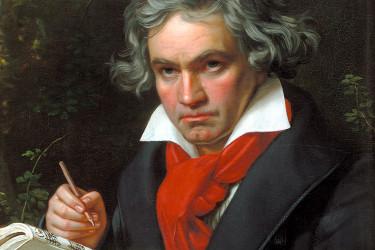Beethoven’s Ninth Symphony at 200
Beethoven’s Ninth Symphony, a monument of the classical symphonic repertoire, turns 200 this year. This symphony, Beethoven’s last, has been seen as a crowning achievement in the composer’s life, the culmination of a life of artistic successes and struggles, and of personal pain, sorrow, and finally acceptance as he dealt with his progressive deafness and declining physical health.

A page from the original manuscript of the Ninth Symphony.
Beethoven emerged from a lengthy period of unproductivity in the late 1810s, writing some of his longest and most ambitious works in the final years of his life—the Missa solemnis (1819–1823) and the Ninth Symphony (1822–1824). In many ways, the Ninth Symphony represented the fulfillment of several ideas Beethoven had been shaping throughout his life. He had wanted to write a vocal setting of Schiller’s “An die Freude” (“Ode to Joy”) since his last days in his hometown of Bonn, Germany, when he was still in his early 20s. He revisited this idea several times, in 1798 and again in 1812, when he sketched the work that would become the Namensfeier overture. In his notebooks, he went through over 200 versions of the “Ode to Joy” theme before settling on the one we know today. Another of his long-term aspirations was to write a symphony containing a choral section. It was only in 1822 that he merged these ambitions with a vision for the final movement that would unite Schiller’s “Ode to Joy” with a grand choral finale.

Perhaps the most famous portrait of Beethoven, Joseph Karl Stieler's 1820 painting depicts the composer holding a manuscript of the Missa Solemnis, which he composed around the same time as he was working on the Ninth Symphony.
When Beethoven finished the symphony in 1824 after two years of arduous work, he was initially reluctant to premiere it in Vienna, as he felt the piece might not be understood by audiences there. He inquired about premiering it in Berlin, but word quickly got around. A number of his friends and admirers assembled a petition of sorts for his recent compositions to be heard in Vienna. Touched by the gesture, Beethoven agreed. The premiere took place before a packed crowd at the Kärntnertortheater on May 7, 1824, comprising a recent overture (op. 124), several movements from the Missa solemnis, and the Ninth Symphony. While Beethoven did appear onstage to supervise the performance, it was kapellmeister Michael Umlauf who actually led the orchestra. At the end of the concert, Beethoven still stood turning the pages of his score, utterly oblivious to the roaring applause. The contralto Caroline Unger finally tugged at his sleeve, pointing at the audience behind him, and he turned and bowed.

Beethoven appears on a Hungarian postage stamp commemorating the 200th anniversary of his birth in 1970. Getty Images.
The first movement emerges gradually from the silence, as if being sculpted from raw materials. Only bare fourths and fifths appear in flashes, as if Beethoven were crafting an image of the heavens out of so many shooting stars. When the main theme finally arrives, it does so forcefully and decisively in D Minor. The bare notes of the opening return, followed by a restatement of the main theme in D Major, prefiguring a dynamic struggle between these two keys that will play out over the course of the symphony.
In place of the typical slow second movement adagio, Beethoven inserts a brisk scherzo. The driving momentum of the initial theme is contrasted by a brighter, dance-like middle theme that soon returns to the darkness of the opening of the movement.
The third movement unfolds in stunning tranquility compared to the two preceding movements, as if intoning a prayer.
The fourth movement begins in total cacophony as the orchestra clangs out the dissonant opening chord and the initial motive, a D Minor arpeggio. The basses immediately interject to refuse it, as if to say “No, this won’t do,” and the orchestra tries another tack. One by one, the themes of each of the previous movements are attempted and then rejected in this way, ending with the orchestra finally settling on the “Ode to Joy” theme. When the orchestra suddenly reverts to the music from the opening of the movement, we hear something completely unexpected: the voice of the baritone soloist. He breaks in using the same melody the basses had carried before, singing Beethoven’s own words, appended as an opening to Schiller’s poetry: “O Freunde, nicht diese Töne!” (Oh, friends, not these sounds!). Beethoven’s addition continues: “Let us sing more cheerful songs, / More full of joy!” Gradually, the rest of the orchestra and the chorus joins in, rejoicing in the triumphant “Ode to Joy,” which sings of differences transcended as men become brothers. With the use of voices in this movement, Beethoven forever shattered the mold of what a symphony could become.
The Ninth Symphony has been used in numerous contexts over the years—as a common cultural touchstone, embedded in film soundtracks and advertisements, and as a popular way for symphony orchestras to mark the New Year. On Christmas Day in 1989, Leonard Bernstein conducted an especially memorable performance of the Ninth in the first concert in Berlin since the fall of the Berlin Wall just weeks earlier. The concert brought together musicians from the former East and West Berlin, marking the occasion by replacing the word “joy” in the “Ode to Joy” with “freedom.” The piece has also been used at the opening of the UN General Assembly, and the “Ode to Joy” theme, sans lyrics, remains the anthem of the European Union.






